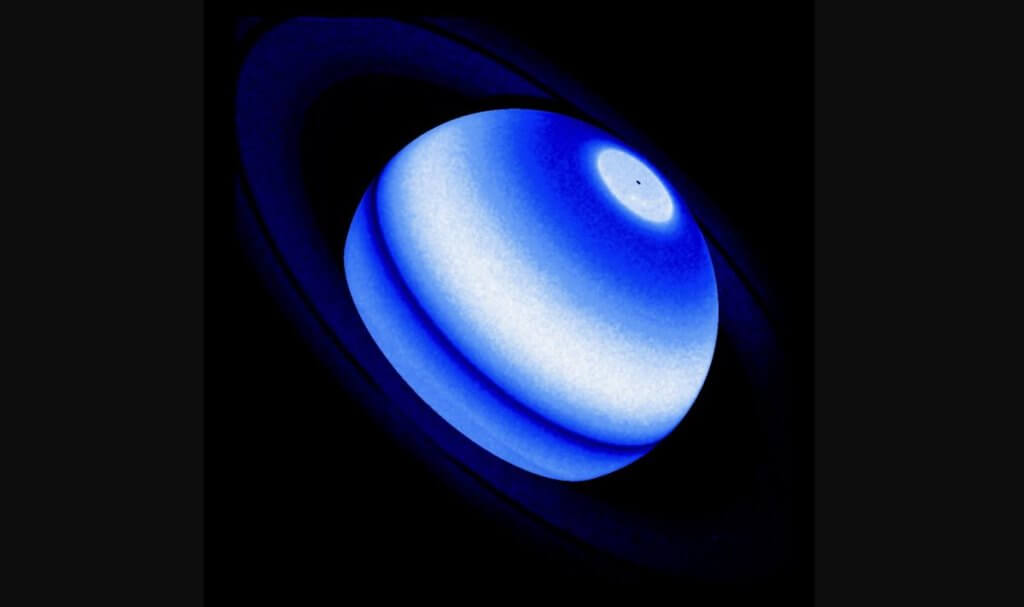
Surprise! Icy ‘rain’ from Saturn’s rings is heating the gas giant’s atmosphere (Image Credit: Space.com)

Icy “rain” from Saturn’s rings is heating the gas giant’s atmosphere, a phenomenon never seen in the solar system before, a new study suggests.
The unexpected discovery, which came as the result of examining data collected from various space missions including NASA’s Hubble Space Telescope, the retired Cassini probe and the Voyager 1 and Voyager 2 spacecraft, could help researchers predict if exoplanets have ring systems.
The telltale evidence of the newfound phenomenon takes the form of a spectral line in light from Saturn, which represents hot hydrogen in the gas giant’s atmosphere. This radiation “bump” indicates that something is contaminating the atmosphere and heating it from the outside.
Related: Saturn’s glorious rings up close (photos)
The most plausible explanation for this heating, study team members said, is icy particles raining down from the rings of Saturn, carrying with them energy that heats the planet’s atmosphere through collisions with other particles.
These raining particles may fall from the rings after being blasted by solar ultraviolet radiation, micrometeorites or particles from the solar wind. Alternatively, electromagnetic forces could be pulling charged dust particles out of the rings. When shaken loose, these particles are drawn by the tremendous gravity of Saturn down toward the planet.
This particle rain was observed by the Cassini probe when it plunged into the gas giant’s atmosphere at the end of its mission in September 2017. But the new study reveals fresh insights about this process.
“Though the slow disintegration of the rings is well known, its influence on the atomic hydrogen of the planet is a surprise,” study lead author Lotfi Ben-Jaffel, of the Institute of Astrophysics in Paris and the Lunar and Planetary Laboratory at the University of Arizona, said in a statement (opens in new tab).
“Everything is driven by ring particles cascading into the atmosphere at specific latitudes,” Ben-Jaffel added. “They modify the upper atmosphere, changing the composition, and then you also have collisional processes with atmospheric gases that are probably heating the atmosphere at a specific altitude.”
The research team reached these conclusions by looking at ultraviolet-light (UV) observations from five space missions that have studied Saturn over the years. The two Voyager probes buzzed the gas giant in the 1980s, measuring UV radiation that researchers at the time dismissed as noise. Then, for years after it arrived at Saturn in 2004, Cassini measured UV data from the atmosphere of the gas giant. These observations were combined with additional data from Hubble and the multinational International Ultraviolet Explorer, which launched to Earth orbit in 1978.
To then ensure that the UV data was accurate and represented an actual physical phenomenon at Saturn, the team turned to measurements made by the Space Telescope Imaging Spectrograph (STIS) instrument aboard Hubble. This data allowed the researchers to calibrate the archival UV observations.
“When everything was calibrated, we saw clearly that the spectra are consistent across all the missions. This was possible because we have the same reference point, from Hubble, on the rate of transfer of energy from the atmosphere as measured over decades,” Ben-Jaffel said. “It was really a surprise for me. I just plotted the different light distribution data together, and then I realized, Wow — it’s the same.”
The team can use the data to follow UV levels at any location across Saturn, which points to the steady “ice rain” from Saturn’s rings as the best explanation for the observations.
“We are just at the beginning of this ring characterization effect on the upper atmosphere of a planet. We eventually want to have a global approach that would yield a real signature about the atmospheres on distant worlds,” Ben-Jaffel said. “One of the goals of this study is to see how we can apply it to planets orbiting other stars. Call it the search for ‘exo-rings.'”
The new study was published on Thursday (March 30) in the Planetary Science Journal (opens in new tab).
Follow us @Spacedotcom (opens in new tab), or on Facebook (opens in new tab) and Instagram (opens in new tab).





